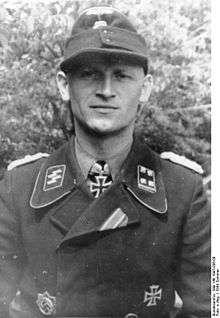Otto Meyer (SS officer)
| Otto Meyer | |
|---|---|
 | |
| Born |
23 December 1912 Moldenit, German Empire |
| Died |
28 August 1944 (aged 31) Duclair, France |
| Allegiance |
|
| Service/branch |
|
| Years of service | 1934–44 |
| Rank | SS-Obersturmbannführer |
| Unit | 9th SS Panzer Division Hohenstaufen |
| Battles/wars | World War II |
| Awards |
Knight's Cross of the Iron Cross with Oak Leaves Iron Cross 1st Class Iron Cross 2nd Class German Cross in Gold |
Otto Meyer (23 December 1912 – 24 August 1944) was an Obersturmbannführer (lieutenant colonel) in the Waffen-SS during World War II who was awarded the Knight's Cross of the Iron Cross with Oak Leaves.[1] The Knight's Cross of the Iron Cross and its higher grade Oak Leaves was awarded to recognise extreme battlefield bravery or successful military leadership.
Career
Meyer volunteered for service in the SS in 1934 and was selected to become an officer in 1936 and posted to the SS-Junkerschule Bad Tölz, upon graduation he was promoted to Untersturmführer (first lieutenant) and posted to the SS Deutschland Regiment.[1] As a company commander he served in the Polish Campaign, the Battle of France, Operation Marita in the Balkans and the invasion of Russia Operation Barbarossa.[1]
On 9 November 1941 he was promoted to Sturmbannführer (major) and in January 1942 awarded the German Cross in Gold for personal bravery.[1] At the beginning of 1943 he was transferred to the 9th SS Panzer Grenadier Division in France and promoted to Obersturmbannführer (lieutenant colonel).[1]
In January 1944 he was given command of the 9th SS Panzer Regiment and for his leadership during the battle for Tarnopol awarded the Knight's Cross.[1] In June 1944 the division served in Normandy where he distinguished both himself and his regiment by destroying over 300 allied tanks. After escaping from the cauldron of Falaise (Falaise Pocket), he was killed crossing the River Seine on 28 August 1944. In September 1944 he was awarded a Posthumous award of the Oakleaves to the Knight's Cross.[1][2]
Awards
- Iron Cross (1939)
- German Cross in Gold on 14 January 1942 as SS-Sturmbannführer in SS-Regiment "Deutschland"[4]
- Knight's Cross of the Iron Cross with Oak Leaves
- Knight's Cross on 4 June 1944 as SS-Obersturmbannführer and commander of SS-Panzer-Regiment 9 "Hohenstaufen"[5][6]
- 601st Oak Leaves on 30 September 1944 as SS-Obersturmbannführer and commander of SS-Panzer-Regiment 9 "Hohenstaufen"[5][7]
References
Citations
Bibliography
- Fellgiebel, Walther-Peer (2000) [1986]. Die Träger des Ritterkreuzes des Eisernen Kreuzes 1939–1945 — Die Inhaber der höchsten Auszeichnung des Zweiten Weltkrieges aller Wehrmachtteile [The Bearers of the Knight's Cross of the Iron Cross 1939–1945 — The Owners of the Highest Award of the Second World War of all Wehrmacht Branches] (in German). Friedberg, Germany: Podzun-Pallas. ISBN 978-3-7909-0284-6.
- Krätschmer, Ernst-Günther (1999). Die Ritterkreuzträger der Waffen-SS [The Knight's Cross Bearers of the Waffen-SS]. Coburg, Germany: Nation Europa Verlag. ISBN 978-3-920677-43-9.
- Patzwall, Klaus D.; Scherzer, Veit (2001). Das Deutsche Kreuz 1941 – 1945 Geschichte und Inhaber Band II [The German Cross 1941 – 1945 History and Recipients Volume 2] (in German). Norderstedt, Germany: Verlag Klaus D. Patzwall. ISBN 978-3-931533-45-8.
- Scherzer, Veit (2007). Die Ritterkreuzträger 1939–1945 Die Inhaber des Ritterkreuzes des Eisernen Kreuzes 1939 von Heer, Luftwaffe, Kriegsmarine, Waffen-SS, Volkssturm sowie mit Deutschland verbündeter Streitkräfte nach den Unterlagen des Bundesarchives [The Knight's Cross Bearers 1939–1945 The Holders of the Knight's Cross of the Iron Cross 1939 by Army, Air Force, Navy, Waffen-SS, Volkssturm and Allied Forces with Germany According to the Documents of the Federal Archives] (in German). Jena, Germany: Scherzers Miltaer-Verlag. ISBN 978-3-938845-17-2.
- Thomas, Franz (1998). Die Eichenlaubträger 1939–1945 Band 2: L–Z [The Oak Leaves Bearers 1939–1945 Volume 2: L–Z] (in German). Osnabrück, Germany: Biblio-Verlag. ISBN 978-3-7648-2300-9.
